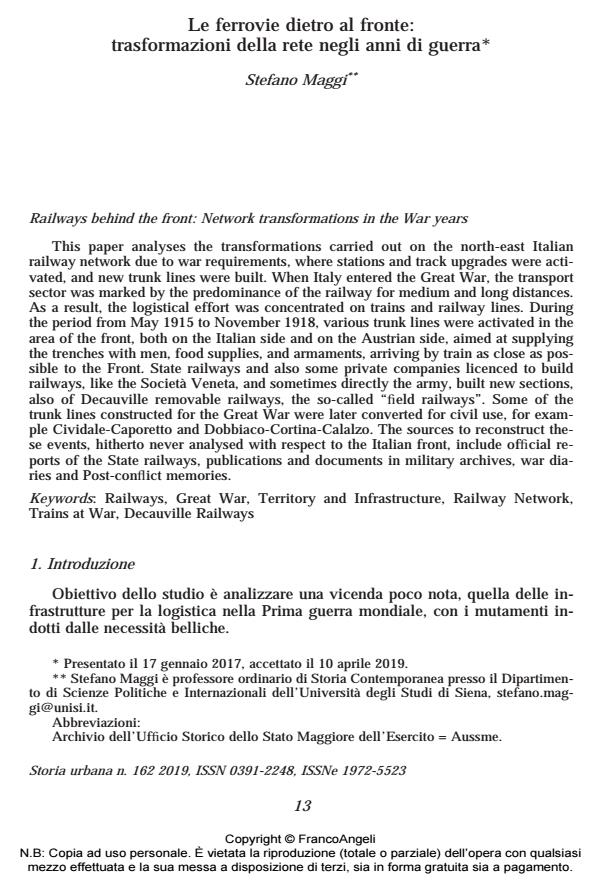Le ferrovie dietro al fronte: trasformazioni della rete negli anni di guerra
Titolo Rivista STORIA URBANA
Autori/Curatori Stefano Maggi
Anno di pubblicazione 2019 Fascicolo 2019/162
Lingua Italiano Numero pagine 25 P. 13-37 Dimensione file 297 KB
DOI 10.3280/SU2019-162002
Il DOI è il codice a barre della proprietà intellettuale: per saperne di più
clicca qui
Qui sotto puoi vedere in anteprima la prima pagina di questo articolo.
Se questo articolo ti interessa, lo puoi acquistare (e scaricare in formato pdf) seguendo le facili indicazioni per acquistare il download credit. Acquista Download Credits per scaricare questo Articolo in formato PDF

FrancoAngeli è membro della Publishers International Linking Association, Inc (PILA)associazione indipendente e non profit per facilitare (attraverso i servizi tecnologici implementati da CrossRef.org) l’accesso degli studiosi ai contenuti digitali nelle pubblicazioni professionali e scientifiche
Il saggio analizza le trasformazioni introdotte dalle necessità belliche sulla rete ferroviaria italiana del nord-est, nella quale si attivarono potenziamenti delle stazioni e dei binari e si costruirono nuovi tratti. Quando l’Italia entrò nella Grande guerra, il settore dei trasporti era contrassegnato dal predominio della ferrovia sulle medie e lunghe distanze. Di conseguenza lo sforzo logistico fu concentrato sui treni e sulle linee ferroviarie. Nel periodo dal maggio 1915 e fino al novembre 1918, nella zona del fronte furono attivati vari tronchi sia dalla parte italiana sia dalla parte austriaca, finalizzati a rifornire le trincee con uomini, vettovaglie, armamenti, arrivando in treno più vicino possibile al fronte. Ferrovie dello Stato, compagnie concessionarie di ferrovie private, come la Società veneta, talvolta direttamente l’esercito, costruirono nuovi tratti, anche di ferrovie smontabili Decauville, le cosiddette ferrovie da campo. Alcuni dei tronchi realizzati per la Grande guerra, furono poi convertiti all’esercizio civile, ad esempio la Cividale-Caporetto e la Dobbiaco-Cortina-Calalzo. Le fonti per ricostruire queste vicende, finora mai analizzate rispetto al fronte italiano, sono rappresentate dalle relazioni ufficiali delle Ferrovie dello Stato, dalle pubblicazioni e dai documento negli archivi militari, dai diari di guerra e dalla memorialistica successiva al conflitto.
Parole chiave:Ferrovie, Grande Guerra, Territorio e infrastrutture, Rete ferroviaria, Treni in guerra, Ferrovie, Decauville
Stefano Maggi, Le ferrovie dietro al fronte: trasformazioni della rete negli anni di guerra in "STORIA URBANA " 162/2019, pp 13-37, DOI: 10.3280/SU2019-162002